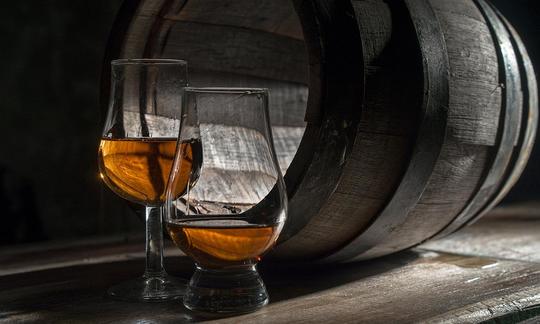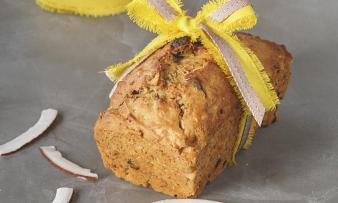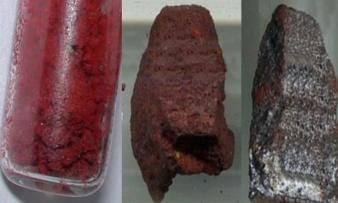Table of contents
Rum is an alcoholic drink (at least 37.5% ABV) made from sugar cane molasses or sugar cane juice. Small amounts of rum can give desserts and pastries a special touch. Organic quality is preferable.
Use in the kitchen
Rum is a spirit obtained by alcoholic fermentation and distillation of juice from sugar cane ( Saccharum officinarum) or from the production of sugar cane molasses or sugar cane syrup. 1,2,3 The alcohol content of rum must be at least 37.5% vol. 4 A rough distinction is made between brown rum, which has matured in wooden barrels, and white rum, which is mostly bottled unmatured. The taste varies depending on the product and can be mild or strong, fruity-sweet or spicy.
In addition to pure consumption, the most well-known use of rum is as an ingredient in all kinds of cocktails, such as Cuba Libre, Daiquiri, Dark'n'Stormy, Mai Tai, Mojito and Pina Colada. Vegan "eggnog" can also be made with the spirit.
Rum is not only suitable for making drinks, but also for cooking and baking. You can use the alcohol to refine pastries and various desserts, such as cakes, strudel, muffins, cookies, puddings and creams. Well-known examples include rum slices and rum balls, a praline made with rum. One or two spoonfuls of rum are usually enough to give the desserts the desired sweet, caramel-like note.
A dash of rum also flavors soups, sauces and marinades, and tastes good in vegetable, lentil and bean stews.
Rumtopf is a well-known preservation method in which seasonal, ripe fruit is marinated in rum and sugar over the summer and autumn. You usually start with strawberries in May/June and then gradually move on to seasonal fruit, such as blackcurrants, apricots, peaches, sour cherries, plums and pears. From December onwards you can enjoy the fruity-sweet rum, neat or mixed, and eat the marinated fruit. The rumtopf fruits are particularly suitable as a topping or filling for crêpes, waffles, cream puffs, vegan rice pudding and ice cream. Dried fruit can also be marinated in rum before you use them for something else, e.g. in a cake or fruit bread.
Is rum vegan? Generally speaking, rum is vegan. However, there are ingredients and manufacturing processes that some brands use that may result in the products not being vegan. Is rum raw? Distillation takes place during the production of rum, which is why rum is not considered raw.
your own
You can make rum with the right equipment, just like other spirits. You can find detailed instructions on the Internet.
Vegan recipe for rum balls
Ingredients: 200 g dark chocolate (vegan), 150 g margarine, 50 g powdered sugar, 125 g almonds (chopped or ground), 2 tablespoons rum (preferably organic), cocoa powder or coconut flakes.
Preparation: Break or chop the dark chocolate into pieces and melt in a warm water bath. Add the margarine, powdered sugar, almonds and rum while stirring constantly. Place the resulting homogenous mixture in the fridge for at least 2 hours. Then form balls from the vegan mixture and roll them in either cocoa powder or coconut flakes.
If you don't want to use powdered sugar, you can use a sugar-free alternative instead, such as erythritol, xylitol or stevia. Please note that you may need to adjust the amount slightly depending on the sugar alternative.
Vegan recipes with rum can be found under the note: " Recipes that have the most of this ingredient ".
| Not only vegans or vegetarians should read this: Vegans often eat unhealthily. Avoidable nutritional errors. |
Purchasing - Storage
In many supermarkets (e.g. Coop, Denner, Volg, Spar, Aldi, Lidl, Rewe, Edeka, Hofer, Billa) you can buy rum in many different qualities and under many names and brands. The supermarket chain Migros does not sell alcohol. Some organic supermarkets (possibly Denn's Biomarkt and Alnatura) have organic rum in their range. Organic rum can also be found in online shops.
According to European guidelines, flavouring rum is prohibited. Only the addition of caramel to adjust the colour is permitted. 4
If you don't drink alcohol, you can choose non-alcoholic rum alternatives. The selection of non-alcoholic rum alternatives is now very large.
The availability of rum varies depending on the size of the store, catchment area, etc. Our recorded food prices for the DA-CH countries can be found above under the ingredient image - and by clicking you can see their development at various suppliers.
Storage tips
Thanks to its high alcohol content, rum has a virtually infinite shelf life if stored in a cool, dark place.
Ingredients - Nutritional values - Calories
100 g of rum has an energy content of 231 kcal. Rum is free of carbohydrates, fats and proteins. 5 The minimum alcohol content of rum is set at 37.5% vol. 4 It contains small amounts (1-2% of the daily requirement) of copper, phosphorus, manganese and thiamine (vitamin B1). 5
Rum gets its typical aroma from ethyl formate (ethyl methanoate or ethyl formate), a colorless liquid that tastes like arrack. 6 Rum also contains phenols, aldehydes, furfurals, acetic acid and esters. 6,7
You can find all the ingredients of rum, the coverage of the daily requirement and comparison values with other ingredients in our nutrient tables. In the article Nutrients explained you will get a detailed insight into the topic.
Health Effects
Is rum healthy? Several studies have examined the potential health benefits of alcohol. Low to moderate alcohol consumption, particularly wine, has been found to have a protective effect on the cardiovascular system.8,9 According to a 2000 study, consuming fewer than 22 drinks of beer, wine and spirits per week was associated with a lower risk of death from coronary heart disease. The reduction in risk was similar for beer and wine consumption, but smaller for spirits consumption and not statistically significant.10 However, using alcohol as a preventive measure for cardiovascular disease is not recommended given the significant risks for many health consequences associated with any alcohol consumption. Alcohol is a carcinogen, neurotoxin, hepatotoxin and psychoactive drug.11
Recent research also casts doubt on those earlier studies linking light to moderate alcohol consumption with a lower risk of cardiovascular disease, and suggests that the protective effects were overestimated. Previous study methods made it difficult to determine whether the positive cardiovascular outcomes were due to low alcohol consumption or instead to factors such as diet, genetics, health history, or behavioral differences between people who drink and those who do not drink. Recent studies also suggest that even moderate alcohol consumption increases the risk of stroke, cancer, and premature death. 12
How much alcohol per day is OK? The U.S. Dietary Guidelines recommend that healthy adults who choose to drink alcohol minimize alcohol-related risks by keeping their intake to a minimum. No more than 1 drink for women (about 150 ml of wine or 10 g of alcohol 8) or 2 drinks for men (about 300 ml of wine or 20 g of alcohol 8) per day is recommended. The amounts are not an average, but rather the amount consumed on a single day. 12 Individual values may vary depending on age, genetics, and use of dietary supplements. 8 For people who are pregnant, taking medications, have medical problems, are minors, plan to drive or operate machinery, and experience dizziness and facial flushing when drinking alcohol, it is safest to avoid alcohol altogether. 12
Secondary plant substances
The doubted protective effects of moderate consumption of alcoholic beverages on the cardiovascular system could, according to the studies, be due to polyphenols or alcohol itself. 8
Dangers - Intolerances - Side effects
Rum has a high alcohol content and should therefore, like other high-proof spirits (and alcoholic beverages in general), be consumed rarely and in moderation.
Excessive alcohol consumption and alcohol abuse are associated with a variety of medical, social and work-related problems, including the development of alcohol dependence syndrome, several chronic diseases (liver cirrhosis, cardiomyopathy, encephalopathies, polyneuropathy, dementia) and accidents that can lead to death. 8 ,13
A 2021 study found a link between alcohol consumption and mortality in Cuba. The most commonly consumed alcohol there was rum. Overall mortality was positively and continuously associated with weekly alcohol consumption: each additional 35 cl bottle of rum per week (110 g of pure alcohol) was associated with an approximately 10% higher risk of overall mortality. The main causes of increased mortality among weekly drinkers were cancer, vascular disease and external causes. 14
Rum is drunk neat or often as a cocktail with syrup or fruit juice. In addition to the harmful effects of alcohol, the health effects of sugar are often added. 13
Ecological footprint - animal welfare
The CO 2 footprint is primarily used to assess the climate friendliness of a food. This depends on various aspects, such as cultivation method (conventional/organic), seasonality, country of origin, processing, transport and, if applicable, packaging. According to the organization Eaternity, spirits have a CO 2 footprint of around 2.8 kg CO 2 eq per quantity of product, which covers 1/3 of the daily requirement. 15
In conventional agriculture, synthetic pesticides are often used to combat unwanted plants and insects. These have been proven to have a negative impact on the environment and affect important pollinators, birds and mammals, among others. Accordingly, when buying rum, you should also buy organic products in order to protect biodiversity and your own health, among other things. The use of such pesticides is prohibited in organic farming.
For detailed explanations of various sustainability indicators (such as ecological footprint, CO2 footprint, water footprint), see our article: What does the ecological footprint mean?.
Worldwide occurrence - cultivation
The Indian subcontinent provided the first evidence of two spirits made from sugar cane. The sacred Indian Vedic texts (Vedas; ca. 2000 BC) mentioned a spirit made from sugar cane juice called "sidhu" and a spirit made from molasses called "gaudi". 7
Rum, as we know it today, originates from the Caribbean. Sugar for the English market was mainly produced on the Caribbean islands, which the English colonized at about the same time as New England. Molasses, a byproduct of refined sugar, fermented easily and was an ideal raw material for distillation. 16
In Demerara, now Guyana, the tradition of distilling dates back to 1670. However, it is likely that the practice is even older. Barbados and Santo Domingo were the pioneers of modern rum production with the colonization of the West Indies in the 17th century. From the 18th century onwards, the spirit made from sugar cane was called "rum". 7
Originally, slaves had to do the work on the sugar plantations and the adjacent distilleries. English ships transported slaves from West Africa in their tens of thousands and later in their hundreds of thousands to the Caribbean, where they sold them or exchanged them for sugar, molasses or rum. The ships loaded with Caribbean products returned to Great Britain via the American colonies, where another exchange/sale took place. The African slaves were in turn bought with the spirits produced. According to one estimate, between 1680 and 1713, 1.3 million gallons of spirits were brought to Africa, which were exchanged for around 60,000 people. 7, 16
Today, rum is produced not only in the Caribbean, but in many tropical and subtropical countries around the world, such as Colombia, Venezuela, Brazil, Ecuador, Peru, Bolivia, Spain, the USA, Australia, India, the Philippines, Indonesia, Thailand, Madagascar, Swaziland and South Africa. 7
Industrial production
The production of rum essentially involves three steps:
- Fermentation
- distillation
- Maturation / Storage
The basis for rum production is mostly sugar cane molasses, less often sugar cane juice. The raw material is processed with water to form a mash and then fermented by adding yeast. Yeast converts the sugar contained in it into alcohol. This is followed by distillation to increase the alcohol content and remove undesirable substances. The alcohol is distilled in different stills using different distillation techniques (pot still or column still). The distillate ultimately has an alcohol content of 65 to 75%. White rum is diluted with distilled water after distillation to reduce the alcohol content (drinking strength). However, the rum is often aged in wooden barrels before being diluted. Contact with wood gives the rum a brownish color and a variety of flavor nuances. 2,17
Further information
Rum is made from sugar cane ( Saccharum officinarum), an upright, tall, tropical grass that was probably introduced to the West Indies by Columbus. 7
There are four types of rum based on the raw material used, the microbiology of the fermentation media and the distillation process: "Rhum Agricole" (from sugar cane juice), "Rhum Industriel" (from molasses), light-flavoured rum and heavy-flavoured rum. 2
In addition, a rough distinction is made between white, i.e. transparent, unaged rum, and brown rum, which has been left to mature in wooden barrels and therefore has a brown color. But be careful: caramel coloring or caramel syrup is sometimes added to rum that has only been stored for a short time in order to simulate the brown color of rum that has been matured for a long time in wooden barrels. In addition, rum that has been matured for a long time can be made transparent again through subsequent filtration. So you cannot always judge the quality and maturation period of the product by the color of the rum.
Alternative names
for rum are also Rhum and Ron, with Ron coming from the Spanish Antilles and Rhum from the French Antilles. The term rum applies to the spirit produced in English-speaking countries. Rum is therefore also referred to as rum in English.
There are various theories about the origin of the word rum. It is possible that rum is derived from the Latin word "saccharum" for sugar. Another derivation comes from the words "rumbullion" and "rumbustion", which come from Devon (a county in the southwest of England) and mean something like great tumult. Others suspect that rum is a corruption of the Spanish word "ron". The Spanish distilled "ron" (rum) in the West Indies long before the British entered the Caribbean. 7
Bibliography - 14 Sources
| 1. | Bortoletto AM. Rum and cachaça. In: Hill A, Jack F (Ed.) Distilled Spirits. Academic Press. 2023:61-74. |
| 2. | Fahrasmane L, Ganou-Parfait B. Microbial flora of rum fermentation media: a review. Journal of Applied Microbiology. 1998;84(6):921–928. |
| 3. | Eidgenössisches Departement des Innern (EDI). Verordnung des EDI über alkoholische Getränke. Vom 29. November 2013 (Stand am 1. Januar 2014). |
| 4. | Verordnung (EU) 2019/787. Des Europäischen Parlaments und des Rates vom 17. April 2019 über die Begriffsbestimmung, Bezeichnung, Aufmachung und Kennzeichnung von Spirituosen, die Verwendung der Bezeichnungen von Spirituosen bei der Aufmachung und Kennzeichnung von anderen Lebensmitteln, den Schutz geografischer Angaben für Spirituosen und die Verwendung von Ethylalkohol und Destillaten landwirtschaftlichen Ursprungs in alkoholischen Getränken sowie zur Aufhebung der Verordnung (EG) Nr. 110/2008. |
| 5. | USDA United States Department of Agriculture. |
| 6. | Rumundco de: Eine technische und chemische Analyse von Rum. |
| 7. | Nicol DA. Rum. In: Lea AGH, Piggott JR (Ed.) Fermented Beverage Production. Springer US; 2003:263-287. |
| 8. | Arranz S, Chiva-Blanch G et al. Wine, beer, alcohol and polyphenols on cardiovascular disease and cancer. Nutrients. 2012;4(7):759-781. |
| 12. | National Institute on Alcohol Abuse and Alcoholism. The Basics: Defining How Much Alcohol is Too Much. 2024. |
| 13. | Anger JP, Kintz P. Is rum toxic? Ann Toxicol Anal. 2008;20(3):137-144. |
| 14. | Armas Rojas NB, Lacey B et al. Alcohol consumption and cause-specific mortality in Cuba: prospective study of 120 623 adults. EClinicalMedicine. 2021;33:100692. |
| 15. | All you can eat for Climate. Spirituosen. |
| 16. | Khaderi SA. Introduction: Alcohol and Alcoholism. Clinics in Liver Disease. 2019;23(1):1-10. |
| 17. | Rumundco de: Die Herstellung von Rum - Wissenschaft, Kunst oder beides? |









Comments